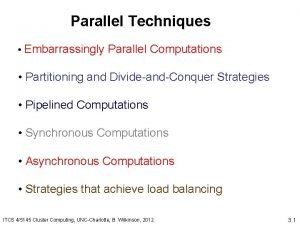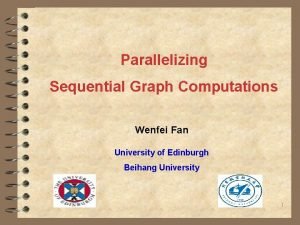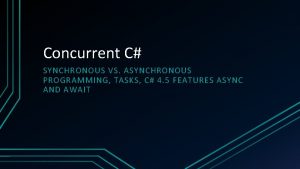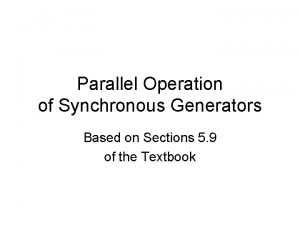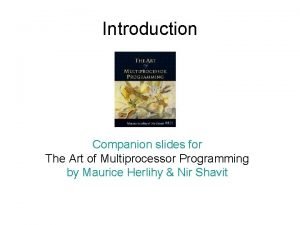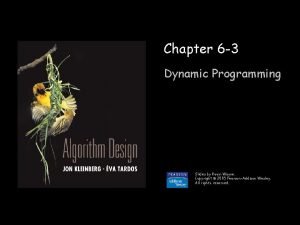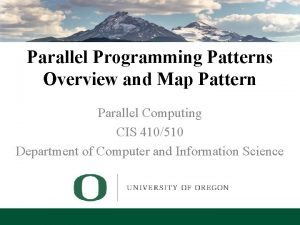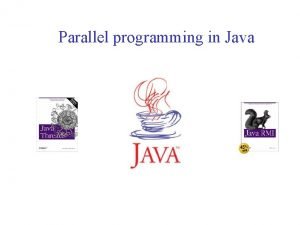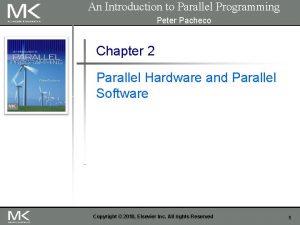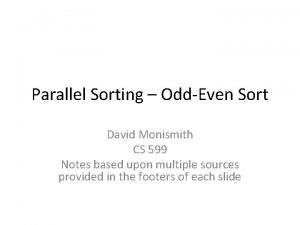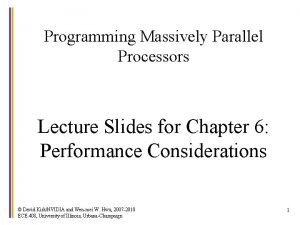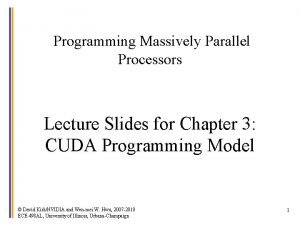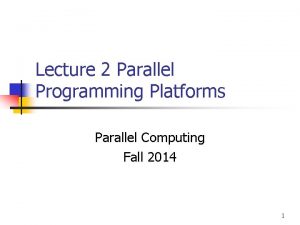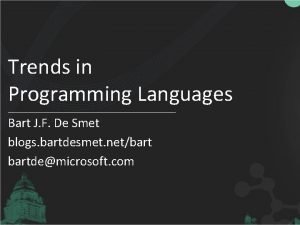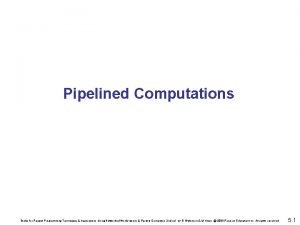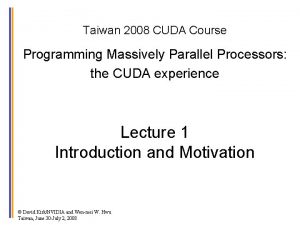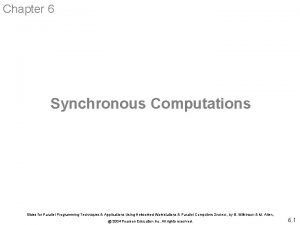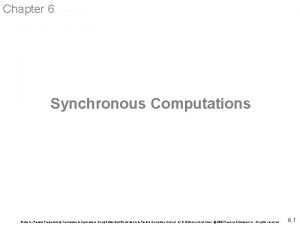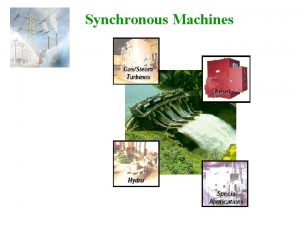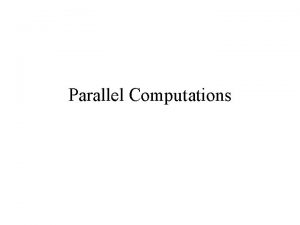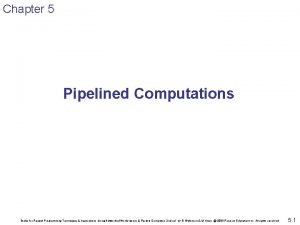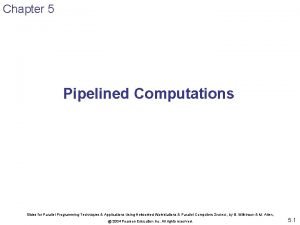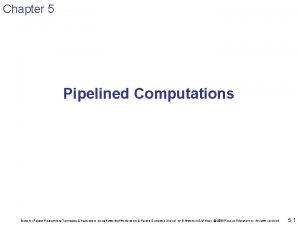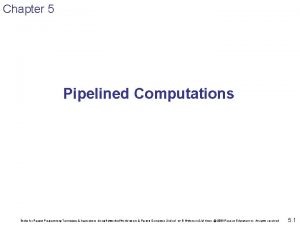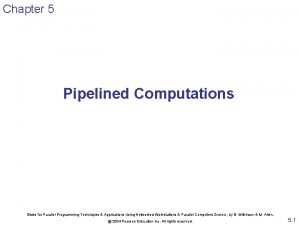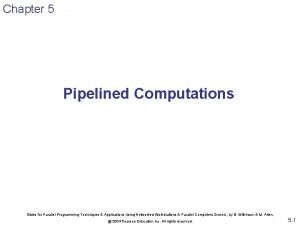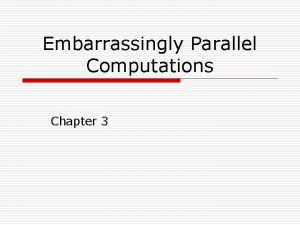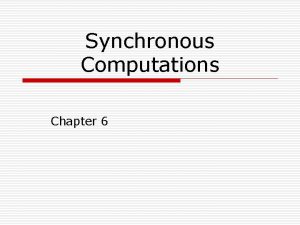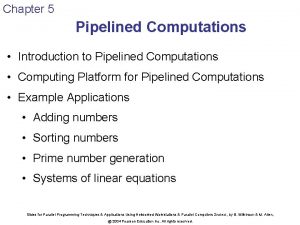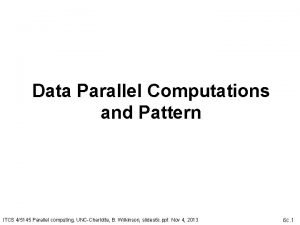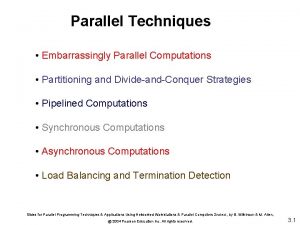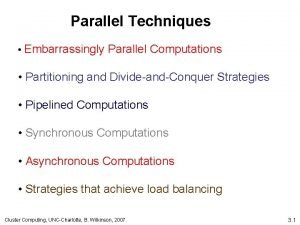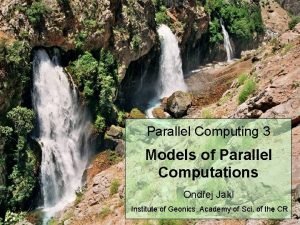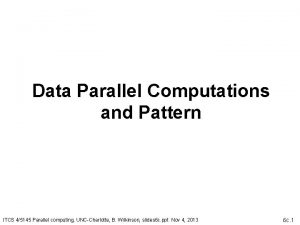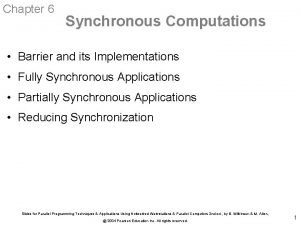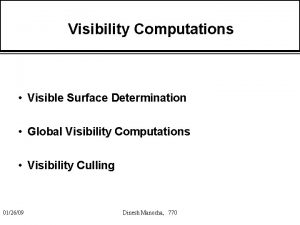Chapter 6 Synchronous Computations Slides for Parallel Programming



































![Parallel Code Process Pi could be of the form x[i] = b[i]; /*initialize unknown*/ Parallel Code Process Pi could be of the form x[i] = b[i]; /*initialize unknown*/](https://slidetodoc.com/presentation_image/f487a4c659fbc9a1e3bf6efc1ee38280/image-36.jpg)










































- Slides: 78

Chapter 6 Synchronous Computations Slides for Parallel Programming Techniques & Applications Using Networked Workstations & Parallel Computers 2 nd ed. , by B. Wilkinson & M. Allen, @ 2004 Pearson Education Inc. All rights reserved. 6. 1

Synchronous Computations In a (fully) synchronous application, all the processes synchronized at regular points. Barrier A basic mechanism for synchronizing processes - inserted at the point in each process where it must wait. All processes can continue from this point when all the processes have reached it (or, in some implementations, when a stated number of processes have reached this point). Slides for Parallel Programming Techniques & Applications Using Networked Workstations & Parallel Computers 2 nd ed. , by B. Wilkinson & M. Allen, @ 2004 Pearson Education Inc. All rights reserved. 6. 2

Processes reaching barrier at different times Slides for Parallel Programming Techniques & Applications Using Networked Workstations & Parallel Computers 2 nd ed. , by B. Wilkinson & M. Allen, @ 2004 Pearson Education Inc. All rights reserved. 6. 3

In message-passing systems, barriers provided with library routines: Slides for Parallel Programming Techniques & Applications Using Networked Workstations & Parallel Computers 2 nd ed. , by B. Wilkinson & M. Allen, @ 2004 Pearson Education Inc. All rights reserved. 6. 4

MPI MPI_Barrier() Barrier with a named communicator being the only parameter. Called by each process in the group, blocking until all members of the group have reached the barrier call and only returning then. Slides for Parallel Programming Techniques & Applications Using Networked Workstations & Parallel Computers 2 nd ed. , by B. Wilkinson & M. Allen, @ 2004 Pearson Education Inc. All rights reserved. 6. 5

Barrier Implementation Centralized counter implementation (a linear barrier): Slides for Parallel Programming Techniques & Applications Using Networked Workstations & Parallel Computers 2 nd ed. , by B. Wilkinson & M. Allen, @ 2004 Pearson Education Inc. All rights reserved. 6. 6

Good barrier implementations must take into account that a barrier might be used more than once in a process. Might be possible for a process to enter the barrier for a second time before previous processes have left the barrier for the first time. Slides for Parallel Programming Techniques & Applications Using Networked Workstations & Parallel Computers 2 nd ed. , by B. Wilkinson & M. Allen, @ 2004 Pearson Education Inc. All rights reserved. 6. 7

Counter-based barriers often have two phases: • A process enters arrival phase and does not leave this phase until all processes have arrived in this phase. • Then processes move to departure phase and are released. Two-phase handles the reentrant scenario. Slides for Parallel Programming Techniques & Applications Using Networked Workstations & Parallel Computers 2 nd ed. , by B. Wilkinson & M. Allen, @ 2004 Pearson Education Inc. All rights reserved. 6. 8

Example code: Master: for (i = 0; i < n; i++) recv(Pany); for (i = 0; i < n; i++) send(Pi); /*count slaves as they reach barrier*/ /* release slaves */ Slave processes: send(Pmaster); recv(Pmaster); Slides for Parallel Programming Techniques & Applications Using Networked Workstations & Parallel Computers 2 nd ed. , by B. Wilkinson & M. Allen, @ 2004 Pearson Education Inc. All rights reserved. 6. 9

Barrier implementation in a message-passing system Slides for Parallel Programming Techniques & Applications Using Networked Workstations & Parallel Computers 2 nd ed. , by B. Wilkinson & M. Allen, @ 2004 Pearson Education Inc. All rights reserved. 6. 10

Tree Implementation More efficient. O(log p) steps Suppose 8 processes, P 0, P 1, P 2, P 3, P 4, P 5, P 6, P 7: 1 st stage: P 1 sends message to P 0; (when P 1 reaches its barrier) P 3 sends message to P 2; (when P 3 reaches its barrier) P 5 sends message to P 4; (when P 5 reaches its barrier) P 7 sends message to P 6; (when P 7 reaches its barrier) 2 nd stage: P 2 sends message to P 0; (P 2 & P 3 reached their barrier) P 6 sends message to P 4; (P 6 & P 7 reached their barrier) 3 rd stage: P 4 sends message to P 0; (P 4, P 5, P 6, & P 7 reached barrier) P 0 terminates arrival phase; (when P 0 reaches barrier & received message from P 4) Release with a reverse tree construction. Slides for Parallel Programming Techniques & Applications Using Networked Workstations & Parallel Computers 2 nd ed. , by B. Wilkinson & M. Allen, @ 2004 Pearson Education Inc. All rights reserved. 6. 11

Tree barrier Slides for Parallel Programming Techniques & Applications Using Networked Workstations & Parallel Computers 2 nd ed. , by B. Wilkinson & M. Allen, @ 2004 Pearson Education Inc. All rights reserved. 6. 12

Butterfly Barrier Slides for Parallel Programming Techniques & Applications Using Networked Workstations & Parallel Computers 2 nd ed. , by B. Wilkinson & M. Allen, @ 2004 Pearson Education Inc. All rights reserved. 6. 13

Local Synchronization Suppose a process Pi needs to be synchronized and to exchange data with process Pi-1 and process Pi+1 before continuing: Not a perfect three-process barrier because process Pi-1 will only synchronize with Pi and continue as soon as Pi allows. Similarly, process Pi+1 only synchronizes with Pi. Slides for Parallel Programming Techniques & Applications Using Networked Workstations & Parallel Computers 2 nd ed. , by B. Wilkinson & M. Allen, @ 2004 Pearson Education Inc. All rights reserved. 6. 14

Deadlock When a pair of processes each send and receive from each other, deadlock may occur. Deadlock will occur if both processes perform the send, using synchronous routines first (or blocking routines without sufficient buffering). This is because neither will return; they will wait for matching receives that are never reached. Slides for Parallel Programming Techniques & Applications Using Networked Workstations & Parallel Computers 2 nd ed. , by B. Wilkinson & M. Allen, @ 2004 Pearson Education Inc. All rights reserved. 6. 15

A Solution Arrange for one process to receive first and then send and the other process to send first and then receive. Example Linear pipeline, deadlock can be avoided by arranging so the even-numbered processes perform their sends first and the odd-numbered processes perform their receives first. Slides for Parallel Programming Techniques & Applications Using Networked Workstations & Parallel Computers 2 nd ed. , by B. Wilkinson & M. Allen, @ 2004 Pearson Education Inc. All rights reserved. 6. 16

Combined deadlock-free blocking sendrecv() routines MPI provides MPI_Sendrecv() and MPI_Sendrecv_replace(). MPI sendrev()s actually has 12 parameters! Slides for Parallel Programming Techniques & Applications Using Networked Workstations & Parallel Computers 2 nd ed. , by B. Wilkinson & M. Allen, @ 2004 Pearson Education Inc. All rights reserved. 6. 17

Synchronized Computations Can be classififed as: • Fully synchronous or • Locally synchronous In fully synchronous, all processes involved in the computation must be synchronized. In locally synchronous, processes only need to synchronize with a set of logically nearby processes, not all processes involved in the computation Slides for Parallel Programming Techniques & Applications Using Networked Workstations & Parallel Computers 2 nd ed. , by B. Wilkinson & M. Allen, @ 2004 Pearson Education Inc. All rights reserved. 6. 18

Fully Synchronized Computation Examples Data Parallel Computations Same operation performed on different data elements simultaneously; i. e. , in parallel. Particularly convenient because: • Ease of programming (essentially one program). • Can scale easily to larger problem sizes. • Many numeric and some non-numeric problems can be cast in a data parallel form. Slides for Parallel Programming Techniques & Applications Using Networked Workstations & Parallel Computers 2 nd ed. , by B. Wilkinson & M. Allen, @ 2004 Pearson Education Inc. All rights reserved. 6. 19

Example To add the same constant to each element of an array: for (i = 0; i < n; i++) a[i] = a[i] + k; The statement: a[i] = a[i] + k; could be executed simultaneously by multiple processors, each using a different index i (0 < i <= n). Slides for Parallel Programming Techniques & Applications Using Networked Workstations & Parallel Computers 2 nd ed. , by B. Wilkinson & M. Allen, @ 2004 Pearson Education Inc. All rights reserved. 6. 20

Data Parallel Computation Slides for Parallel Programming Techniques & Applications Using Networked Workstations & Parallel Computers 2 nd ed. , by B. Wilkinson & M. Allen, @ 2004 Pearson Education Inc. All rights reserved. 6. 21

forall construct Special “parallel” construct in parallel programming languages to specify data parallel operations Example forall (i = 0; i < n; i++) { body } states that n instances of the statements of the body can be executed simultaneously. One value of the loop variable i is valid in each instance of the body, the first instance has i = 0, the next i = 1, and so on. Slides for Parallel Programming Techniques & Applications Using Networked Workstations & Parallel Computers 2 nd ed. , by B. Wilkinson & M. Allen, @ 2004 Pearson Education Inc. All rights reserved. 6. 22

To add k to each element of an array, a, we can write forall (i = 0; i < n; i++) a[i] = a[i] + k; Slides for Parallel Programming Techniques & Applications Using Networked Workstations & Parallel Computers 2 nd ed. , by B. Wilkinson & M. Allen, @ 2004 Pearson Education Inc. All rights reserved. 6. 23

Data parallel technique applied to multiprocessors and multicomputers Example To add k to the elements of an array: i = myrank; a[i] = a[i] + k; /* body */ barrier(mygroup); where myrank is a process rank between 0 and n - 1. Slides for Parallel Programming Techniques & Applications Using Networked Workstations & Parallel Computers 2 nd ed. , by B. Wilkinson & M. Allen, @ 2004 Pearson Education Inc. All rights reserved. 6. 24

Data Parallel Example Prefix Sum Problem Given a list of numbers, x 0, …, xn-1, compute all the partial summations, i. e. : x 0 + x 1; x 0 + x 1 + x 2 + x 3; … ). Can also be defined with associative operations other than addition. Widely studied. Practical applications in areas such as processor allocation, data compaction, sorting, and polynomial evaluation. Slides for Parallel Programming Techniques & Applications Using Networked Workstations & Parallel Computers 2 nd ed. , by B. Wilkinson & M. Allen, @ 2004 Pearson Education Inc. All rights reserved. 6. 25

Data parallel method of adding all partial sums of 16 numbers Slides for Parallel Programming Techniques & Applications Using Networked Workstations & Parallel Computers 2 nd ed. , by B. Wilkinson & M. Allen, @ 2004 Pearson Education Inc. All rights reserved. 6. 26

Data parallel prefix sum operation Slides for Parallel Programming Techniques & Applications Using Networked Workstations & Parallel Computers 2 nd ed. , by B. Wilkinson & M. Allen, @ 2004 Pearson Education Inc. All rights reserved. 6. 27

Slides for Parallel Programming Techniques & Applications Using Networked Workstations & Parallel Computers 2 nd ed. , by B. Wilkinson & M. Allen, @ 2004 Pearson Education Inc. All rights reserved. 6. 28

Synchronous Iteration (Synchronous Parallelism) Each iteration composed of several processes that start together at beginning of iteration. Next iteration cannot begin until all processes have finished previous iteration. Using forall construct: for (j = 0; j < n; j++) /*for each synch. iteration */ forall (i = 0; i < N; i++) { /*N procs each using*/ body(i); /* specific value of i */ } Slides for Parallel Programming Techniques & Applications Using Networked Workstations & Parallel Computers 2 nd ed. , by B. Wilkinson & M. Allen, @ 2004 Pearson Education Inc. All rights reserved. 6. 29

Using message passing barrier: for (j = 0; j < n; j++) { i = myrank; body(i); barrier(mygroup); } /*for each synchr. iteration */ /*find value of i to be used */ Slides for Parallel Programming Techniques & Applications Using Networked Workstations & Parallel Computers 2 nd ed. , by B. Wilkinson & M. Allen, @ 2004 Pearson Education Inc. All rights reserved. 6. 30

Another fully synchronous computation example Solving a General System of Linear Equations by Iteration Suppose the equations are of a general form with n equations and n unknowns where the unknowns are x 0, x 1, x 2, … xn-1 (0 <= i < n). Slides for Parallel Programming Techniques & Applications Using Networked Workstations & Parallel Computers 2 nd ed. , by B. Wilkinson & M. Allen, @ 2004 Pearson Education Inc. All rights reserved. 6. 31

By rearranging the ith equation: This equation gives xi in terms of the other unknowns. Can be be used as an iteration formula for each of the unknowns to obtain better approximations. Slides for Parallel Programming Techniques & Applications Using Networked Workstations & Parallel Computers 2 nd ed. , by B. Wilkinson & M. Allen, @ 2004 Pearson Education Inc. All rights reserved. 6. 32

Jacobi Iteration All values of x are updated together. Can be proven that Jacobi method will converge if diagonal values of a have an absolute value greater than sum of the absolute values of the other a’s on the row (the array of a’s is diagonally dominant) i. e. if This condition is a sufficient but not a necessary condition. Slides for Parallel Programming Techniques & Applications Using Networked Workstations & Parallel Computers 2 nd ed. , by B. Wilkinson & M. Allen, @ 2004 Pearson Education Inc. All rights reserved. 6. 33

Termination A simple, common approach. Compare values computed in one iteration to values obtained from the previous iteration. Terminate computation when all values are within given tolerance; i. e. , when However, this does not guarantee the solution to that accuracy. Slides for Parallel Programming Techniques & Applications Using Networked Workstations & Parallel Computers 2 nd ed. , by B. Wilkinson & M. Allen, @ 2004 Pearson Education Inc. All rights reserved. 6. 34

Convergence Rate Slides for Parallel Programming Techniques & Applications Using Networked Workstations & Parallel Computers 2 nd ed. , by B. Wilkinson & M. Allen, @ 2004 Pearson Education Inc. All rights reserved. 6. 35
![Parallel Code Process Pi could be of the form xi bi initialize unknown Parallel Code Process Pi could be of the form x[i] = b[i]; /*initialize unknown*/](https://slidetodoc.com/presentation_image/f487a4c659fbc9a1e3bf6efc1ee38280/image-36.jpg)
Parallel Code Process Pi could be of the form x[i] = b[i]; /*initialize unknown*/ for (iteration = 0; iteration < limit; iteration++) { sum = -a[i][i] * x[i]; for (j = 0; j < n; j++) /* compute summation */ sum = sum + a[i][j] * x[j]; new_x[i] = (b[i] - sum) / a[i][i]; /* compute unknown */ allgather(&new_x[i]); /*bcast/rec values */ global_barrier(); /* wait for all procs */ } allgather() sends the newly computed value of x[i] from process i to every other process and collects data broadcast from the other processes. Slides for Parallel Programming Techniques & Applications Using Networked Workstations & Parallel Computers 2 nd ed. , by B. Wilkinson & M. Allen, @ 2004 Pearson Education Inc. All rights reserved. 6. 36

Introduce a new message-passing operation - Allgather Broadcast and gather values in one composite construction. Slides for Parallel Programming Techniques & Applications Using Networked Workstations & Parallel Computers 2 nd ed. , by B. Wilkinson & M. Allen, @ 2004 Pearson Education Inc. All rights reserved. 6. 37

Partitioning Usually number of processors much fewer than number of data items to be processed. Partition the problem so that processors take on more than one data item. Slides for Parallel Programming Techniques & Applications Using Networked Workstations & Parallel Computers 2 nd ed. , by B. Wilkinson & M. Allen, @ 2004 Pearson Education Inc. All rights reserved. 6. 38

block allocation – allocate groups of consecutive unknowns to processors in increasing order. cyclic allocation – processors are allocated one unknown in order; i. e. , processor P 0 is allocated x 0, xp, x 2 p, …, x((n/p)-1)p, processor P 1 is allocated x 1, xp+1, x 2 p+1, …, x((n/p)-1)p+1, and so on. Cyclic allocation no particular advantage here (Indeed, may be disadvantageous because the indices of unknowns have to be computed in a more complex way). Slides for Parallel Programming Techniques & Applications Using Networked Workstations & Parallel Computers 2 nd ed. , by B. Wilkinson & M. Allen, @ 2004 Pearson Education Inc. All rights reserved. 6. 39

Effects of computation and communication in Jacobi iteration Consequences of different numbers of processors done in textbook. Get: Slides for Parallel Programming Techniques & Applications Using Networked Workstations & Parallel Computers 2 nd ed. , by B. Wilkinson & M. Allen, @ 2004 Pearson Education Inc. All rights reserved. 6. 40

Locally Synchronous Computation Heat Distribution Problem An area has known temperatures along each of its edges. Find the temperature distribution within. Slides for Parallel Programming Techniques & Applications Using Networked Workstations & Parallel Computers 2 nd ed. , by B. Wilkinson & M. Allen, @ 2004 Pearson Education Inc. All rights reserved. 6. 41

Divide area into fine mesh of points, hi, j. Temperature at an inside point taken to be average of temperatures of four neighboring points. Convenient to describe edges by points. Temperature of each point by iterating the equation: (0 < i < n, 0 < j < n) for a fixed number of iterations or until the difference between iterations less than some very small amount. Slides for Parallel Programming Techniques & Applications Using Networked Workstations & Parallel Computers 2 nd ed. , by B. Wilkinson & M. Allen, @ 2004 Pearson Education Inc. All rights reserved. 6. 42

Heat Distribution Problem Slides for Parallel Programming Techniques & Applications Using Networked Workstations & Parallel Computers 2 nd ed. , by B. Wilkinson & M. Allen, @ 2004 Pearson Education Inc. All rights reserved. 6. 43

Natural ordering of heat distribution problem Slides for Parallel Programming Techniques & Applications Using Networked Workstations & Parallel Computers 2 nd ed. , by B. Wilkinson & M. Allen, @ 2004 Pearson Education Inc. All rights reserved. 6. 44

Number points from 1 for convenience and include those representing the edges. Each point will then use the equation Could be written as a linear equation containing the unknowns xi-m, xi-1, xi+1, and xi+m: Notice: solving a (sparse) system Also solving Laplace’s equation. Slides for Parallel Programming Techniques & Applications Using Networked Workstations & Parallel Computers 2 nd ed. , by B. Wilkinson & M. Allen, @ 2004 Pearson Education Inc. All rights reserved. 6. 45

Sequential Code Using a fixed number of iterations for (iteration = 0; iteration < limit; iteration++) { for (i = 1; i < n; i++) for (j = 1; j < n; j++) g[i][j] = 0. 25*(h[i-1][j]+h[i+1][j]+h[i][j-1]+h[i][j+1]); for (i = 1; i < n; i++) /* update points */ for (j = 1; j < n; j++) h[i][j] = g[i][j]; } using original numbering system (n x n array). Slides for Parallel Programming Techniques & Applications Using Networked Workstations & Parallel Computers 2 nd ed. , by B. Wilkinson & M. Allen, @ 2004 Pearson Education Inc. All rights reserved. 6. 46

To stop at some precision: do { for (i = 1; i < n; i++) for (j = 1; j < n; j++) g[i][j] = 0. 25*(h[i-1][j]+h[i+1][j]+h[i][j-1]+h[i][j+1]); for (i = 1; i < n; i++) for (j = 1; j < n; j++) h[i][j] = g[i][j]; /* update points */ continue = FALSE; /* indicates whether to continue */ for (i = 1; i < n; i++)/* check each pt for convergence */ for (j = 1; j < n; j++) if (!converged(i, j) {/* point found not converged */ continue = TRUE; break; } } while (continue == TRUE); Slides for Parallel Programming Techniques & Applications Using Networked Workstations & Parallel Computers 2 nd ed. , by B. Wilkinson & M. Allen, @ 2004 Pearson Education Inc. All rights reserved. 6. 47

Parallel Code With fixed number of iterations, Pi, j (except for the boundary points): Important to use send()s that do not block while waiting for recv()s; otherwise processes would deadlock, each waiting for a recv() before moving on - recv()s must be synchronous and wait for send()s. Slides for Parallel Programming Techniques & Applications Using Networked Workstations & Parallel Computers 2 nd ed. , by B. Wilkinson & M. Allen, @ 2004 Pearson Education Inc. All rights reserved. 6. 48

Message passing for heat distribution problem Slides for Parallel Programming Techniques & Applications Using Networked Workstations & Parallel Computers 2 nd ed. , by B. Wilkinson & M. Allen, @ 2004 Pearson Education Inc. All rights reserved. 6. 49

Version where processes stop when they reach their required precision: Slides for Parallel Programming Techniques & Applications Using Networked Workstations & Parallel Computers 2 nd ed. , by B. Wilkinson & M. Allen, @ 2004 Pearson Education Inc. All rights reserved. 6. 50

Slides for Parallel Programming Techniques & Applications Using Networked Workstations & Parallel Computers 2 nd ed. , by B. Wilkinson & M. Allen, @ 2004 Pearson Education Inc. All rights reserved. 6. 51

Example A room has four walls and a fireplace. Temperature of wall is 20°C, and temperature of fireplace is 100°C. Write a parallel program using Jacobi iteration to compute the temperature inside the room and plot (preferably in color) temperature contours at 10°C intervals using Xlib calls or similar graphics calls as available on your system. Slides for Parallel Programming Techniques & Applications Using Networked Workstations & Parallel Computers 2 nd ed. , by B. Wilkinson & M. Allen, @ 2004 Pearson Education Inc. All rights reserved. 6. 52

Sample student output Slides for Parallel Programming Techniques & Applications Using Networked Workstations & Parallel Computers 2 nd ed. , by B. Wilkinson & M. Allen, @ 2004 Pearson Education Inc. All rights reserved. 6. 53

Partitioning Normally allocate more than one point to each processor, because many more points than processors. Points could be partitioned into square blocks or strips: Slides for Parallel Programming Techniques & Applications Using Networked Workstations & Parallel Computers 2 nd ed. , by B. Wilkinson & M. Allen, @ 2004 Pearson Education Inc. All rights reserved. 6. 54

Block partition Four edges where data points exchanged. Communication time given by Slides for Parallel Programming Techniques & Applications Using Networked Workstations & Parallel Computers 2 nd ed. , by B. Wilkinson & M. Allen, @ 2004 Pearson Education Inc. All rights reserved. 6. 55

Strip partition Two edges where data points are exchanged. Communication time is given by Slides for Parallel Programming Techniques & Applications Using Networked Workstations & Parallel Computers 2 nd ed. , by B. Wilkinson & M. Allen, @ 2004 Pearson Education Inc. All rights reserved. 6. 56

Optimum In general, strip partition best for large startup time, and block partition best for small startup time. With the previous equations, block partition has a larger communication time than strip partition if Slides for Parallel Programming Techniques & Applications Using Networked Workstations & Parallel Computers 2 nd ed. , by B. Wilkinson & M. Allen, @ 2004 Pearson Education Inc. All rights reserved. 6. 57

Startup times for block and strip partitions Slides for Parallel Programming Techniques & Applications Using Networked Workstations & Parallel Computers 2 nd ed. , by B. Wilkinson & M. Allen, @ 2004 Pearson Education Inc. All rights reserved. 6. 58

Ghost Points Additional row of points at each edge that hold values from adjacent edge. Each array of points increased to accommodate ghost rows. Slides for Parallel Programming Techniques & Applications Using Networked Workstations & Parallel Computers 2 nd ed. , by B. Wilkinson & M. Allen, @ 2004 Pearson Education Inc. All rights reserved. 6. 59

Safety and Deadlock When all processes send their messages first and then receive all of their messages is “unsafe” because it relies upon buffering in the send()s. The amount of buffering is not specified in MPI. If insufficient storage available, send routine may be delayed from returning until storage becomes available or until the message can be sent without buffering. Then, a locally blocking send() could behave as a synchronous send(), only returning when the matching recv() is executed. Since a matching recv() would never be executed if all the send()s are synchronous, deadlock would occur. Slides for Parallel Programming Techniques & Applications Using Networked Workstations & Parallel Computers 2 nd ed. , by B. Wilkinson & M. Allen, @ 2004 Pearson Education Inc. All rights reserved. 6. 60

Making the code safe Alternate the order of the send()s and recv()s in adjacent processes so that only one process performs the send()s first. Then even synchronous send()s would not cause deadlock. Good way you can test for safety is to replace messagepassing routines in a program with synchronous versions. Slides for Parallel Programming Techniques & Applications Using Networked Workstations & Parallel Computers 2 nd ed. , by B. Wilkinson & M. Allen, @ 2004 Pearson Education Inc. All rights reserved. 6. 61

MPI Safe Message Passing Routines MPI offers several methods for safe communication: Slides for Parallel Programming Techniques & Applications Using Networked Workstations & Parallel Computers 2 nd ed. , by B. Wilkinson & M. Allen, @ 2004 Pearson Education Inc. All rights reserved. 6. 62

Other fully synchronous problems Cellular Automata The problem space is divided into cells. Each cell can be in one of a finite number of states. Cells affected by their neighbors according to certain rules, and all cells are affected simultaneously in a “generation. ” Rules re-applied in subsequent generations so that cells evolve, or change state, from generation to generation. Most famous cellular automata is the “Game of Life” devised by John Horton Conway, a Cambridge mathematician. Slides for Parallel Programming Techniques & Applications Using Networked Workstations & Parallel Computers 2 nd ed. , by B. Wilkinson & M. Allen, @ 2004 Pearson Education Inc. All rights reserved. 6. 63

The Game of Life Board game - theoretically infinite two-dimensional array of cells. Each cell can hold one “organism” and has eight neighboring cells, including those diagonally adjacent. Initially, some cells occupied. The following rules apply: 1. Every organism with two or three neighboring organisms survives for the next generation. 2. Every organism with four or more neighbors dies from overpopulation. 3. Every organism with one neighbor or none dies from isolation. 4. Each empty cell adjacent to exactly three occupied neighbors will give birth to an organism. These rules were derived by Conway “after a long period of experimentation. ” Slides for Parallel Programming Techniques & Applications Using Networked Workstations & Parallel Computers 2 nd ed. , by B. Wilkinson & M. Allen, @ 2004 Pearson Education Inc. All rights reserved. 6. 64

Simple Fun Examples of Cellular Automata “Sharks and Fishes” An ocean could be modeled as a three-dimensional array of cells. Each cell can hold one fish or one shark (but not both). Fish and sharks follow “rules. ” Slides for Parallel Programming Techniques & Applications Using Networked Workstations & Parallel Computers 2 nd ed. , by B. Wilkinson & M. Allen, @ 2004 Pearson Education Inc. All rights reserved. 6. 65

Fish Might move around according to these rules: 1. If there is one empty adjacent cell, the fish moves to this cell. 2. If there is more than one empty adjacent cell, the fish moves to one cell chosen at random. 3. If there are no empty adjacent cells, the fish stays where it is. 4. If the fish moves and has reached its breeding age, it gives birth to a baby fish, which is left in the vacating cell. 5. Fish die after x generations. Slides for Parallel Programming Techniques & Applications Using Networked Workstations & Parallel Computers 2 nd ed. , by B. Wilkinson & M. Allen, @ 2004 Pearson Education Inc. All rights reserved. 6. 66

Sharks Might be governed by the following rules: 1. If one adjacent cell is occupied by a fish, the shark moves to this cell and eats the fish. 2. If more than one adjacent cell is occupied by a fish, the shark chooses one fish at random, moves to the cell occupied by the fish, and eats the fish. 3. If no fish are in adjacent cells, the shark chooses an unoccupied adjacent cell to move to in a similar manner as fish move. 4. If the shark moves and has reached its breeding age, it gives birth to a baby shark, which is left in the vacating cell. 5. If a shark has not eaten for y generations, it dies. Slides for Parallel Programming Techniques & Applications Using Networked Workstations & Parallel Computers 2 nd ed. , by B. Wilkinson & M. Allen, @ 2004 Pearson Education Inc. All rights reserved. 6. 67

Sample Student Output Slides for Parallel Programming Techniques & Applications Using Networked Workstations & Parallel Computers 2 nd ed. , by B. Wilkinson & M. Allen, @ 2004 Pearson Education Inc. All rights reserved. 6. 68

Similar examples: “foxes and rabbits” - Behavior of rabbits to move around happily whereas behavior of foxes is to eat any rabbits they come across. Slides for Parallel Programming Techniques & Applications Using Networked Workstations & Parallel Computers 2 nd ed. , by B. Wilkinson & M. Allen, @ 2004 Pearson Education Inc. All rights reserved. 6. 69

Serious Applications for Cellular Automata Examples • fluid/gas dynamics • the movement of fluids and gases around objects • diffusion of gases • biological growth • airflow across an airplane wing • erosion/movement of sand at a beach or riverbank. Slides for Parallel Programming Techniques & Applications Using Networked Workstations & Parallel Computers 2 nd ed. , by B. Wilkinson & M. Allen, @ 2004 Pearson Education Inc. All rights reserved. 6. 70

Partially Synchronous Computations in which individual processes operate without needing to synchronize with other processes on every iteration. Important idea because synchronizing processes is an expensive operation which very significantly slows the computation and a major cause for reduced performance of parallel programs is due to the use of synchronization. Global synchronization done with barrier routines. Barriers cause processor to wait sometimes needlessly. Slides for Parallel Programming Techniques & Applications Using Networked Workstations & Parallel Computers 2 nd ed. , by B. Wilkinson & M. Allen, @ 2004 Pearson Education Inc. All rights reserved. 6. 71

Heat Distribution Problem Revisited To solve heat distribution problem, solution space divided into a two dimensional array of points. The value of each point computed by taking average of four points around it repeatedly until values converge on the solution to a sufficient accuracy. The waiting can be reduced by not forcing synchronization at each iteration. Slides for Parallel Programming Techniques & Applications Using Networked Workstations & Parallel Computers 2 nd ed. , by B. Wilkinson & M. Allen, @ 2004 Pearson Education Inc. All rights reserved. 6. 72

Slides for Parallel Programming Techniques & Applications Using Networked Workstations & Parallel Computers 2 nd ed. , by B. Wilkinson & M. Allen, @ 2004 Pearson Education Inc. All rights reserved. 6. 73

First section of code computing the next iteration values based on the immediate previous iteration values is traditional Jacobi iteration method. Suppose however, processes are to continue with the next iteration before other processes have completed. Then, the processes moving forward would use values computed from not only the previous iteration but maybe from earlier iterations. Method then becomes an asynchronous iterative method. Slides for Parallel Programming Techniques & Applications Using Networked Workstations & Parallel Computers 2 nd ed. , by B. Wilkinson & M. Allen, @ 2004 Pearson Education Inc. All rights reserved. 6. 74

Asynchronous Iterative Method – Convergence Mathematical conditions for convergence may be more strict. Each process may not be allowed to use any previous iteration values if the method is to converge. Slides for Parallel Programming Techniques & Applications Using Networked Workstations & Parallel Computers 2 nd ed. , by B. Wilkinson & M. Allen, @ 2004 Pearson Education Inc. All rights reserved. 6. 75

Chaotic Relaxation A form of asynchronous iterative method introduced by Chazan and Miranker (1969) in which the conditions are stated as: “there must be a fixed positive integer s such that, in carrying out the evaluation of the ith iterate, a process cannot make use of any value of the components of the jth iterate if j < i - s” (Baudet, 1978). Slides for Parallel Programming Techniques & Applications Using Networked Workstations & Parallel Computers 2 nd ed. , by B. Wilkinson & M. Allen, @ 2004 Pearson Education Inc. All rights reserved. 6. 76

The final part of the code, checking for convergence of every iteration can also be reduced. It may be better to allow iterations to continue for several iterations before checking for convergence. Slides for Parallel Programming Techniques & Applications Using Networked Workstations & Parallel Computers 2 nd ed. , by B. Wilkinson & M. Allen, @ 2004 Pearson Education Inc. All rights reserved. 6. 77

Overall Parallel Code Each process allowed to perform s iterations before being synchronized and also to update the array as it goes. At s iterations, maximum divergence recorded. Convergence is checked then. The actual iteration corresponding to the elements of the array being used at any time may be from an earlier iteration but only up to s iterations previously. May be a mixture of values of different iterations as array is updated without synchronizing with other processes - truly a chaotic situation. Slides for Parallel Programming Techniques & Applications Using Networked Workstations & Parallel Computers 2 nd ed. , by B. Wilkinson & M. Allen, @ 2004 Pearson Education Inc. All rights reserved. 6. 78
 Embarrassingly parallel computations
Embarrassingly parallel computations When graphs are life
When graphs are life Synchronous vs asynchronous programming
Synchronous vs asynchronous programming Parallel operation of generators
Parallel operation of generators A small child slides down the four frictionless slides
A small child slides down the four frictionless slides Force and work relationship quick check
Force and work relationship quick check Multiprocessor
Multiprocessor Dynamic programming slides
Dynamic programming slides Perbedaan linear programming dan integer programming
Perbedaan linear programming dan integer programming Greedy vs dynamic programming
Greedy vs dynamic programming What is system programming
What is system programming Linear vs integer programming
Linear vs integer programming Definisi integer
Definisi integer Programming massively parallel processors
Programming massively parallel processors Parallel programming patterns
Parallel programming patterns Parallel programming in java
Parallel programming in java An introduction to parallel programming peter pacheco
An introduction to parallel programming peter pacheco Counting sort mpi
Counting sort mpi Mpi critical section
Mpi critical section Programming massively parallel processors
Programming massively parallel processors Programming massively parallel processors
Programming massively parallel processors Parallel programming platforms
Parallel programming platforms F# parallel programming
F# parallel programming Parallel programming
Parallel programming Programming massively parallel processors, kirk et al.
Programming massively parallel processors, kirk et al. Kontinuitetshantering i praktiken
Kontinuitetshantering i praktiken Novell typiska drag
Novell typiska drag Nationell inriktning för artificiell intelligens
Nationell inriktning för artificiell intelligens Vad står k.r.å.k.a.n för
Vad står k.r.å.k.a.n för Varför kallas perioden 1918-1939 för mellankrigstiden
Varför kallas perioden 1918-1939 för mellankrigstiden En lathund för arbete med kontinuitetshantering
En lathund för arbete med kontinuitetshantering Underlag för särskild löneskatt på pensionskostnader
Underlag för särskild löneskatt på pensionskostnader Tidbok
Tidbok Anatomi organ reproduksi
Anatomi organ reproduksi Förklara densitet för barn
Förklara densitet för barn Datorkunskap för nybörjare
Datorkunskap för nybörjare Boverket ka
Boverket ka Att skriva debattartikel
Att skriva debattartikel Magnetsjukhus
Magnetsjukhus Nyckelkompetenser för livslångt lärande
Nyckelkompetenser för livslångt lärande Påbyggnader för flakfordon
Påbyggnader för flakfordon Arkimedes princip formel
Arkimedes princip formel Svenskt ramverk för digital samverkan
Svenskt ramverk för digital samverkan Jag har nigit för nymånens skära
Jag har nigit för nymånens skära Presentera för publik crossboss
Presentera för publik crossboss Argument för teckenspråk som minoritetsspråk
Argument för teckenspråk som minoritetsspråk Kanaans land
Kanaans land Treserva lathund
Treserva lathund Luftstrupen för medicinare
Luftstrupen för medicinare Claes martinsson
Claes martinsson Cks
Cks Programskede byggprocessen
Programskede byggprocessen Mat för unga idrottare
Mat för unga idrottare Verktyg för automatisering av utbetalningar
Verktyg för automatisering av utbetalningar Rutin för avvikelsehantering
Rutin för avvikelsehantering Smärtskolan kunskap för livet
Smärtskolan kunskap för livet Ministerstyre för och nackdelar
Ministerstyre för och nackdelar Tack för att ni har lyssnat
Tack för att ni har lyssnat Referat mall
Referat mall Redogör för vad psykologi är
Redogör för vad psykologi är Matematisk modellering eksempel
Matematisk modellering eksempel Atmosfr
Atmosfr Borra hål för knoppar
Borra hål för knoppar Vilken grundregel finns det för tronföljden i sverige?
Vilken grundregel finns det för tronföljden i sverige? Stickprovsvariansen
Stickprovsvariansen Tack för att ni har lyssnat
Tack för att ni har lyssnat Rita perspektiv
Rita perspektiv Verksamhetsanalys exempel
Verksamhetsanalys exempel Tobinskatten för och nackdelar
Tobinskatten för och nackdelar Toppslätskivling dos
Toppslätskivling dos Mästar lärling modellen
Mästar lärling modellen Egg för emanuel
Egg för emanuel Elektronik för barn
Elektronik för barn Fredsgudinna
Fredsgudinna Strategi för svensk viltförvaltning
Strategi för svensk viltförvaltning Kung dog 1611
Kung dog 1611 Ellika andolf
Ellika andolf Romarriket tidslinje
Romarriket tidslinje Tack för att ni lyssnade
Tack för att ni lyssnade
